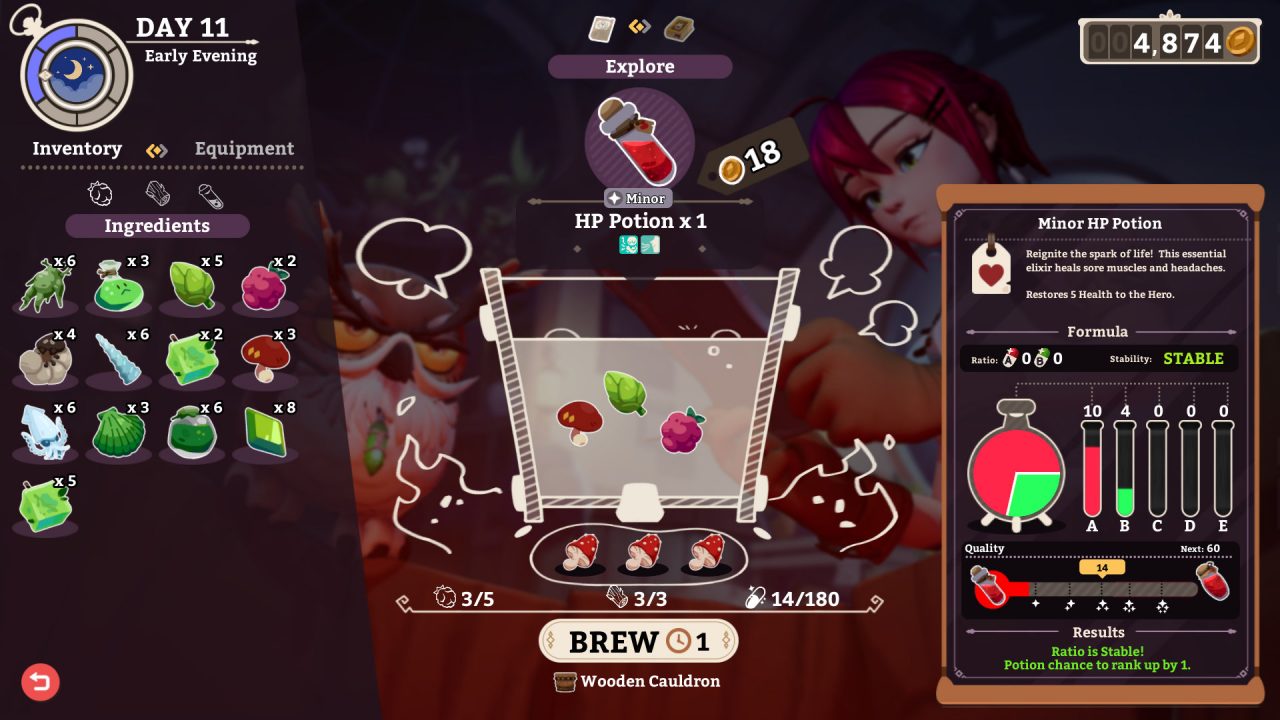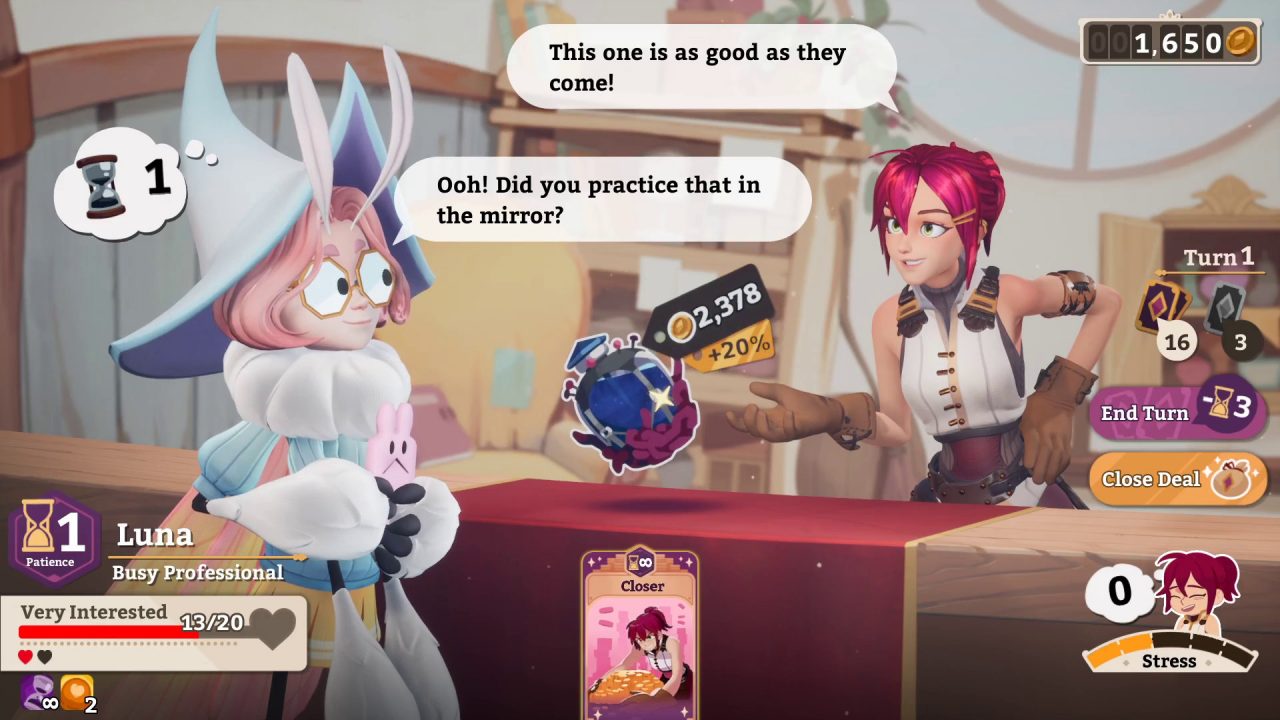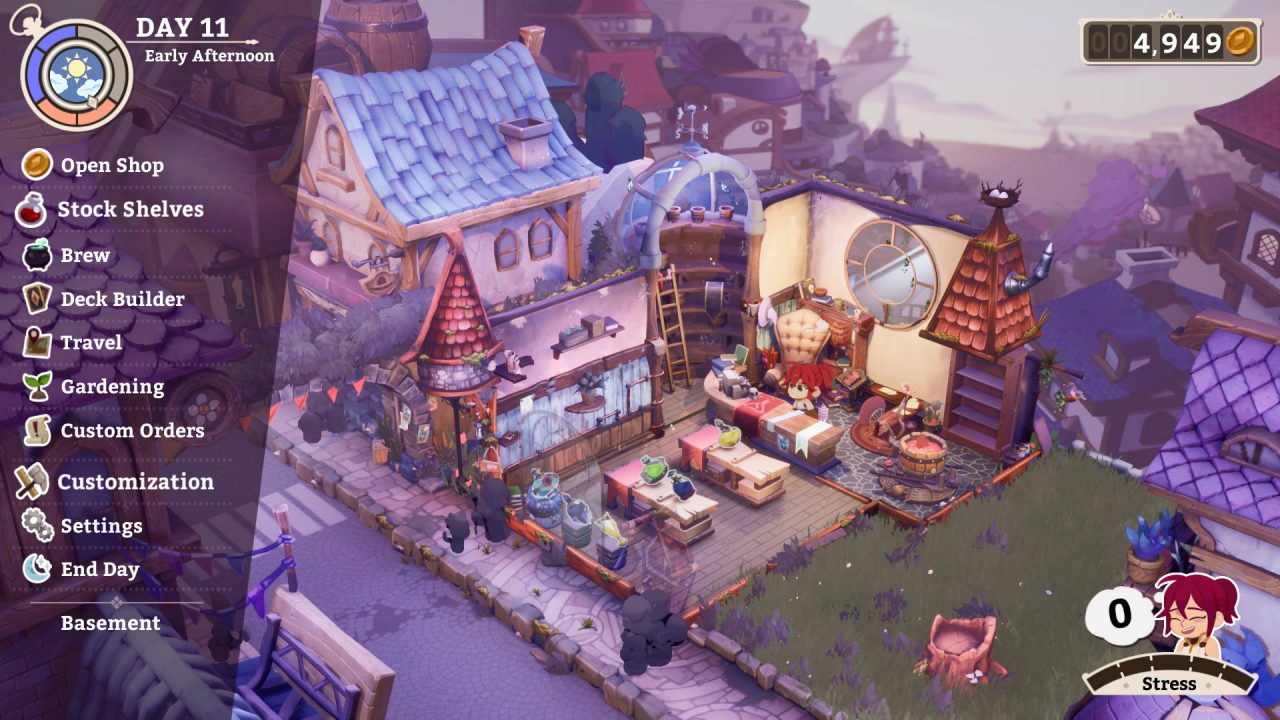Potion-brewing games seem to be all the rage these days. For good reason, too: if you want to design a game that fantastically involves crafting, enigmatic potions allow all sorts of fun mixing nonsense. The ingredients can fall under almost any category, as witches of olde would combine oddities like eye of newt and troll’s blood. Potionomics offers the same sort of cauldron antics but with a pinch of deck building, relationship sim, resource management, and economy all added together to seamlessly accentuate the focus of concocting colorful drinks. Oh, and also math. A heaping scoop of math. For flavor. I guess.
Enter Sylvia, heir to her uncle’s humble potion shop and massive debt to a bank. From this modest beginning, she has to convert Uncle Oswald’s shack into a small empire as she enlists adventurers equipped with her potions into the wilds in search of new ingredients and the help of several other denizens on this remote island. At the end of every ten days, a contest occurs with another local potion maker whose work is compared by dollar value with her potions. Win the competition, and a large sum of money goes to Sylvia and then immediately to the bank to pay a piece of the debt owed.
At first, Sylvia meets only a few people who work with her—at a cost, of course. As Potionomics progresses, Sylvia meets more people who offer different talents to improve her business in various ways. While doing so, she can gift or spend time with each of these inhabitants in town to build her relationship with them. Aside from chatting and parading around town in these meaty asides, the friend will also teach Sylvia a technique in the form of a card that will help her sell her potions.

Aside from brewing potions, the other primary focus of Potionomics is selling said potions. Every day offers six “time” that players can spend opening the shop for two points of time or going into town for one point of time. The potion’s base value depends on its potency and positive or negative qualities; however, Sylvia is a haggling artist who uses cards in her twenty-card deck to brag about or convince the shopper into paying more than the base value. As a meter fills with “interest” points, thresholds are hit that will jack up the price by ten, fifteen, twenty, etc. percent, typically dependent on how much interest is needed to fill a gauge. Most consumers will have three or more bars to fill before they’re maxed out, which is not always easy. As this is a card-driven exercise, luck plays a role, and players have to know how to use what they’re dealt.
The interactions with customers extend beyond simply applying interest points, though; customers will sometimes stress Sylvia out, raising the percentage chance of her drawing stress cards each turn that clog her hand and further add to her stress. Stress can have a runaway effect that can catch players by surprise. I often found myself with only a few percentage points of stress that cascaded into double digits quickly. Fortunately, Sylvia can combat this with stress reduction and shield cards that block stress after she ends her turn. Potionomics also has buffs, debuffs, and miscellaneous effects that can cater to various strategies depending on which friend players focus their time on in town. All of this is held together by customer “patience,” which is an ever-decreasing point value each time a card is played or Sylvia ends her turn. When patience reaches zero, the customer leaves without buying the potion.
Brewing potions involves a great deal of calculation, especially as the game extends beyond every ten days. Initially, players only have to brew things like health and mana potions, but then fire resistance potions and enhancement potions become available. Aside from being an avenue for profit when opening the shop, adventurers in town can be equipped with these potions to help them conquer dungeons out in the wild. This process is thoroughly planned out before adventurers go out, with players understanding all hurdles that the adventurer might run into, including monster health, elemental affinities, traps, and duration of the trek. To equip adventurers, players must mix and bottle the goods.

While on the menu at home, Sylvia leans over one, two, or several more cauldrons depending on how far in the game she is. Each cauldron has a different ingredient limit and capacity of magic points it can muster. Each ingredient has different magic point values in one of five categories easily labeled as A, B, C, D, and E. A ingredients are the most common, while E ingredients are the rarest. For example, slime might increase B-type magic by six points, while fire citrus might increase A and C magic values by 48 and 16, respectively. Some ingredients increase three, four, or all five attributes, but be careful with your ratios. Each potion requires different magic types and ratios, with some being a simple 1:1 in two areas, while others could be 1:1:2 or 3:4:3. This can become incredibly taxing as ingredients have some degree of pattern to them, with a few ingredients having mixed values of 12 and 6 in two different categories or others having a 32 and 32 combination. Thankfully, Potionomics is not so unreasonable that players can expect seemingly random values such as 37, 51, and 48 in one ingredient.
Regardless, potion crafting can be a laborious process that takes quite a while if one wants to “perfect” every bottle. All because Potionomics insists on a ratio, that doesn’t mean players have to follow that exact ratio. Close enough can still produce a good potion, but extra stars are awarded if the ratio is perfect. Every potion upgrades in rating (e.g. greater, grand, superior, etc.) depending on how potent it is based on stars earned. This means a 75-point capacity beginner cauldron can only brew weaker potions suitable for the start of the game, while later cauldrons can hold 400 or more magic points. So, if players want to successfully balance a 3:4:3 potion using 400 points with a large yet limited array of ingredients, making potion after potion with depleting resources will require some mathematical creativity.
Players can shop in town and do a bunch of other tasks to expand ingredients in tow, but shops only offer 10 of one component at most every day, and those ingredients can cost a lot of money. In addition, some shops may only have four, two, or even one unit in stock of a given ingredient per day. To add complexity, ingredients can include different affinities to the five senses, either negatively or positively. As one might expect, positive traits increase the value of potions while negative traits diminish value; similarly, ingredients will cost more or less depending on their inherent qualities.
Shops only have access to known ingredients, though. Sending adventurers out or investing in the guild hall can introduce new ingredients that the shop will then be able to sell. Adventuring can feel costly or foolish even, as adventurers require several potions and a fee to succeed, but this is a necessary task to find more and better ingredients. Players can also purchase cauldrons or shelf upgrades to allow for more substantial potions or to increase the value of potions on display. A woodworking friend can improve the shop by creating space for additional shelves and cauldrons, or offer fuel to decrease the time it takes for a potion to finish. Marketing specialists can make certain potions more profitable at the shop for a day or two.
All of these systems flow intuitively well together and create one satisfying unit. For the first half of the game, I found Potionomics to be a surprisingly deep, complex, and rewarding experience. At around twenty or so hours, though, the surprises end and the grind begins. As the contests increase in difficulty, the demand for more upgrades requires more money, which requires new ingredients and more of that mathematically creative brewing. Initially, this was fun, but every day in the allotted ten-day window, I was brewing four or more cauldrons worth of potions three times, and the math became less and less interesting.

I should note that my playstyle leaned heavily on efficiency and perfectionist tendencies. Essentially, the trap I found myself in could have been of my own making. By the second to last competition, I had more money than the earnings of the contest promised, and I had no way of spending it all. Abusing the systems offered allowed me to sell potions for several thousand gold twice a day with a short trip to town to stock up and fund my adventurers’ expeditions. Almost every potion I brewed was “perfect” in terms of the ratio, and if they weren’t, I had calculated it so that the potion would rank up if it was close enough to a perfect brew. A less intense approach may have made for a shorter and more engaging experience. Regardless, this doesn’t change the fact that Potionomics stops introducing new mechanics or surprising story beats around the halfway point. The delivery becomes shockingly flat and repetitive.
One aspect that helped push me along was the presentation. Potionomics has a sleek, exceptionally well-animated art style that brings the characters to life, though even these movements become stale with time. The game boasts a rich palette that breathes character into this world. Musically, Potionomics’ tunes and sound effects are adequate, but only one cat-themed track stands out above the rest; the other tracks are largely forgettable. In terms of controls, I found placing potions in shops to be finicky at times. Otherwise, they didn’t get in the way of the experience, which is important given the amount of clicking and dragging Potionomics demands.
At the outset, I was raving about Potionomics. I had modest expectations going into this title, given its cartoony aesthetic and cliché plot, but I love fantasy-based shopkeep games like Recettear, so I gave it a go. Again, I could not believe just how complex and deep the varied systems flowed together. Building a deck based on relationships I made was always exciting, just as seeing the interest increase with each sale was. Unfortunately, the bag of tricks emptied halfway through this fifty-hour investment, leaving me eager to exit the whole affair.


